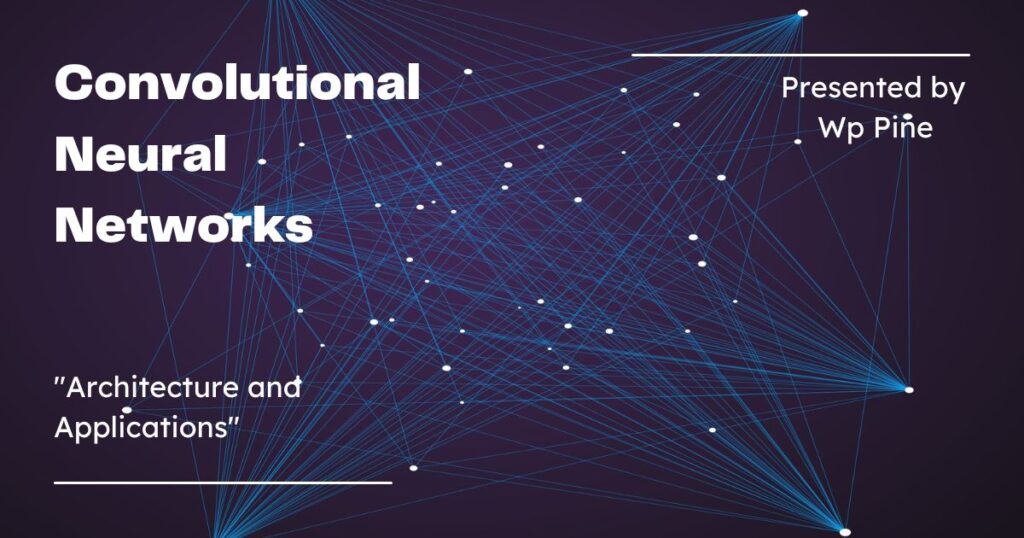Convolutional Neural Networks have revolutionized the domain of computer vision and image processing. CNNs are powerful models which can take meaningful patterns from the visual data for image classification, object detection, facial recognition, and other tasks that reach new levels of accuracy and efficiency.
This paper discusses CNNs, describing their architecture, major components, training procedures, and the general applications of CNNs in business.
Concept of Convolutional Neural Networks
Convolutional neural networks are one variety of deep neural networks specifically designed to work with structured grid-like data, such as images. Their great inspiration involves both the organization and activities of the visual cortexes of animals, and on top of that, in visualization-related applications, they showcase a high degree of skill in extracting hierarchical features
Key Components:
- Convolutional Layers: A layer that convolves input images against learnable filters/kernels for feature extraction such as edges, textures, and patterns.
- Pooling Layers: These reduce the dimensionalities of feature maps, keeping only essential features.
- Activation Functions: Adding non-linearity to the network; normally ReLU for CNNs.
- Fully Connected Layers: Each neuron in one layer connects to all neurons in the next, allowing classification or regression.
Architecture of Convolutional Neural Networks
- Input Layer: Receives the raw pixel values of the input image.
- Convolutional Layers: Perform convolution operations to extract features.
- Activation Function (ReLU): Introduce non-linearity to the model.
- Pooling Layers: Reduce spatial dimensions of feature maps.
- Flattening: Convert 2D feature maps into 1D vectors.
- Fully connected layers: Process the flattened features for classification or regression.
- Output Layer: produces the final output, such as class probabilities in classification tasks.
Training Convolutional Neural Networks
Training CNNs involves the following steps:
- Data Preparation
- Collect and preprocess labeled datasets.
- Normalize pixel values and augment data to enhance model robustness.
- Forward Propagation: Compute predictions using current model parameters.
- Calculate Loss: Measure the difference between predicted and actual outputs using a loss function (e.g., cross-entropy for classification).
- Backpropagation: Compute gradients of the loss concerning model parameters using the chain rule.
- Update Weights: Use optimization algorithms (e.g., SGD, Adam) to update weights and minimize the loss iteratively.
Applications of Convolutional Neural Networks
CNNs have widespread applications in various fields:
- Image Classification: Images are classified accordingly into pre-defined classes, like breeds of a dog, written digits, etc.
- Object Detection: Locate and classify objects within images or videos (e.g., autonomous driving, surveillance).
- Face Recognition: Identification and verification of people through their facial features.
- Medical Imaging: Medical images are analyzed to diagnose an illness, such as tumor detection or disease classification.
- Natural Language Processing (NLP): Analyzing and generating text using various techniques, one of which is performing convolution on text sequences.
- Video Analytics
- It understands motion and actions in video sequences.
- Example: Security surveillance systems detecting suspicious activity.
- Art Generation
- Creating artistic renderings using neural style transfer.
- Example: Transforming a photograph into a Van Gogh-like painting.
Recent Developments
Advancements in CNNs continue to push the boundaries of AI.
- Transfer Learning: This approach of fine-tuning pre-trained CNN models, for example, VGG and ResNet, on particular tasks with limited data significantly saves training time while improving performance.
- Attention Mechanisms: enhance model performance by focusing on important regions of input data.
- 3D CNNs: extend CNNs to process spatiotemporal data, such as videos and 3D medical images.
- Capsule networks have been presented as an alternative to CNNs for handling hierarchical relationships in features in a better way.
Challenges and Concerns
- Computational Resources: Training deep CNNs can be computationally expensive, hence requiring a minimum of GPUs or TPUs.
- Overfitting: Overfitting is one of the most common problems in the case of small datasets. Therefore, dropout and data augmentation are used.
- Interpretability: CNNs are often considered black boxes, making it challenging to interpret their decisions.
Key Outcomes
With the advent of the Convolutional Neural Network, the landscape of computer vision and image processing has dramatically changed. Now, the hierarchy created through this architecture can directly learn from raw data, opening up breakthroughs in research paradigms that go well beyond what bounded the world of image-related applications. End.
As further developed, CNNs entered and penetrated many industries, bringing innovative solutions in fields such as the analysis of medical images, self-driving cars, and even creative creation. Therefore, any analysis of the architecture of a CNN, the training process, and numerous applications has become necessary for most people who try to seize the power of deep learning in solving everyday problems. And their future development opens the road to an increasingly intelligent and automated future.
Additional Resources
Dive deeper into these convolutional neural networks, practice with real datasets, and continue expanding your knowledge. Share this guide with others and leave your thoughts or questions in the comments!
For further exploration of convolutional neural networks and related topics, consider these resources:
- Learn more about Convolutional Neural Networks in detail on Wikipedia
- Differences Between Meta Learning and Machine Learning by Wppine
- Top 10 Machine Learning Algorithms For Beginner Data Scientists by Wppine
- Learn How Recurrent Neural Networks Works by Wppine




Pingback: Learn How Recurrent Neural Networks Works For Data Analysis